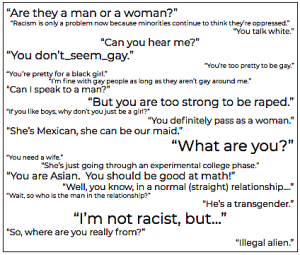Microaggressions
By: Kelsey Gurganus, Director of Research & Evaluation, DVN
We have all heard them, and we have have all probably said them, whether accidently, subconsciously, or purposefully. They are often subtle and dismissed as “it is not a big deal,” “you are just being sensitive,” or “it was kind of a joke, but you know it’s true!” However, microaggressions do matter and can deeply harm the individual at the brunt of the statement.
Microaggressions are “brief and commonplace daily verbal, behavioral, and environmental indignities, whether intentional or unintentional, that communicate hostile, derogatory, or negative..slights” to a target person that belong to a stigmatized group.1 The term was originally coined to speak particularly to racialized experiences.1 Microaggressions also go far into stigmas and biases around gender, sexuality, sexual orientation, mental health, age, ability, culture, religion, and the intersectionality of identities. Some of the most harmful forms of microaggressions remain outside the level of conscious awareness (subconscious bias). Making them visible is the first step in overcoming these biases.
Through my research, I stumbled across The Microaggressions Project blog and facebook page. This incredibly raw and enlightening project seeks to provide a visual representation of power, privilege, and microaggressions in everyday life. The project is NOT about showing how ignorant people can be in order to simply dismiss their ignorance. Instead, it is about showing how microaggressions create and enforce uncomfortable, violent and unsafe realities onto peoples’ workplace, home, school, childhood/adolescence/adulthood, and public transportation/space environments.
As individuals devoted to bettering society and helping others, I challenge you to work toward understanding your own subconscious biases through education and training, as well as pointing out a microaggression when you hear one. Whether at home, work, out with friends, or visiting family, in order to really work toward a more equitable, inclusive, and kind community, we must make the invisible visible.
1Derald Wing Sue, Christina M. Capodilupo, Gina C. Torino, Jennifer M. Bucceri, Aisha M. B. Holder, Kevin L. Nadal, and Marta Esquilin. (2007). “Racial Microaggressions in Everyday Life: Implications for Clinical Practice.” American Psychologist, 62 (4) 271-286.
